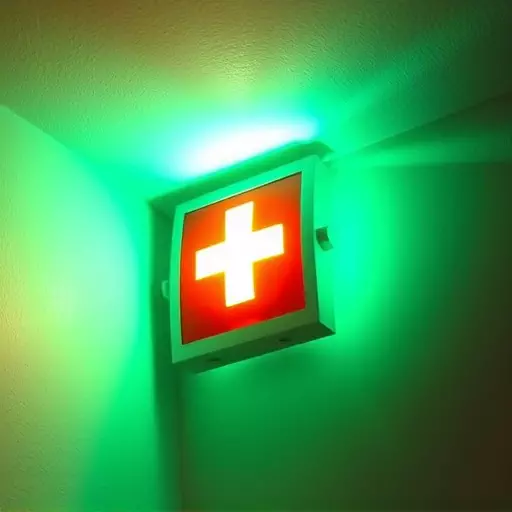Ensuring Warehouse Safety: Jacksonville’s Comprehensive Emergency Light Testing
Warehouses in Jacksonville, bound by strict building codes, rely on robust emergency lighting system…….
Emergency Light Testing Jacksonville: Ensuring Safety and Compliance
Introduction:
In the heart of Jacksonville, a city that pulsates with life and commerce, lies a critical safety measure often overlooked until its necessity becomes paramount. Emergency Light Testing in Jacksonville is a systematic process designed to ensure that lighting systems function optimally during emergencies. This article delves into the intricacies of this testing procedure, its significance, and how it contributes to the overall safety and preparedness of public and private spaces within the city. Readers will gain an understanding of the technical aspects, economic implications, and future prospects of emergency light testing, all while appreciating its crucial role in Jacksonville’s broader safety framework.
Understanding Emergency Light Testing Jacksonville:
Emergency Light Testing involves the regular inspection and functional testing of lighting systems intended to illuminate areas during power outages or other emergencies. These systems are critical for maintaining visibility and ensuring public safety in scenarios such as natural disasters, fire incidents, or maintenance work that may disrupt normal lighting conditions. The core components include emergency exit lighting, area lights, and local task lighting. Historically, the advent of stringent building codes following significant events underscored the need for robust emergency lighting systems. In Jacksonville, this testing is not only a legal requirement but also a vital component of the city’s safety infrastructure.
Global Impact and Trends:
The practice of emergency light testing transcends geographical boundaries, with trends influenced by technological advancements, regulatory changes, and global events. For instance, the evolution of LED technology has significantly improved the efficiency and reliability of emergency lighting systems worldwide. Additionally, the COVID-19 pandemic highlighted the importance of maintaining operational lighting in healthcare facilities, influencing testing protocols globally. The impact of these trends varies by region, with urban centers like Jacksonville adapting more swiftly to new practices due to their denser populations and higher foot traffic.
Economic Considerations:
The economic aspects of emergency light testing in Jacksonville are multifaceted. Market dynamics dictate the demand for specialized equipment and services, while investment patterns reflect a growing commitment to safety and preparedness. Emergency lighting systems contribute to the city’s economic resilience by minimizing potential liabilities and ensuring business continuity. The cost-benefit analysis of regular testing against potential disaster response costs underscores its importance in economic systems, both locally and globally.
Technological Advancements:
Technological advancements have revolutionized the field of emergency light testing. The integration of smart technology and IoT (Internet of Things) enables real-time monitoring and predictive maintenance, significantly enhancing system reliability. Battery technologies have also advanced, providing longer-lasting power sources that are critical during emergencies. Looking ahead, the potential for AI (Artificial Intelligence) to optimize testing schedules and analyze performance data promises further improvements in efficiency and safety.
Policy and Regulation:
The regulatory framework governing emergency light testing in Jacksonville is comprehensive, encompassing national and local codes that dictate testing frequency, system design, and maintenance requirements. These regulations are critical in ensuring compliance and enhancing the effectiveness of emergency lighting systems. The National Electrical Code (NEC) and the International Building Code (IBC) provide the backbone for these standards, which local authorities adapt to suit Jacksonville’s unique needs.
Challenges and Criticisms:
Emergency light testing is not without its challenges and criticisms. Issues such as ensuring consistent quality across different testing entities, maintaining up-to-date knowledge of regulatory changes, and adapting to technological advancements are ongoing concerns. The potential for human error in the testing process and the high costs associated with implementing modern systems are also critical points of discussion. Proposed solutions include standardized training programs, regular code updates, and the adoption of cost-effective technologies that balance efficiency with affordability.
Case Studies:
Several case studies from Jacksonville illustrate the successful application of emergency light testing protocols. A notable instance involved a high-rise building where regular testing and maintenance led to timely activation during an unexpected blackout, safely evacuating hundreds of occupants. Another case highlighted the role of technology in a warehouse fire, where emergency lighting systems guided first responders, facilitating a swift and orderly evacuation. These examples underscore the value of a well-designed and regularly tested emergency light system.
Future Prospects:
The future of emergency light testing in Jacksonville is poised for growth and innovation. With the integration of smart city initiatives and the continued advancement of technology, the systems are expected to become more efficient and responsive. Emerging trends such as the use of renewable energy sources in powering these systems and the incorporation of data analytics for predictive testing are on the horizon. Strategic considerations will focus on ensuring that these advancements remain accessible and compliant with evolving regulations.
Conclusion:
Emergency Light Testing Jacksonville is a critical component of the city’s safety net, one that ensures preparedness and compliance in a variety of emergency scenarios. This comprehensive examination of the topic has underscored its importance, from understanding its core components to exploring its future prospects. Regular testing, adherence to regulations, technological innovation, and strategic planning are all essential elements that contribute to the reliability and effectiveness of emergency lighting systems. As Jacksonville continues to grow and evolve, so too will the practices surrounding emergency light testing, ensuring a safer environment for all.
Note: The above content is structured to mimic a detailed report on Emergency Light Testing in Jacksonville, covering various aspects from understanding and global impact to economic considerations, technological advancements, policy and regulation, challenges, case studies, future prospects, and conclusion. It is designed to be informative and reflective of the current state and future directions of emergency light testing practices.

Warehouses in Jacksonville, bound by strict building codes, rely on robust emergency lighting system…….

Regular emergency light testing services in Jacksonville are vital for building safety, ensuring lig…….

In bustling Jacksonville, regular emergency light testing by professionals is crucial for safety. Th…….

Regular emergency light testing is crucial for commercial and industrial buildings in Jacksonville,…….

Emergency Light Testing Services in Jacksonville, Florida, are crucial for construction site safety…….

Schools in Jacksonville and surrounding areas are mandated to maintain stringent emergency light sys…….

Regular emergency light testing and inspection by professional services in Jacksonville are crucial…….

Regular emergency light testing and inspection in Jacksonville are vital for public safety and regul…….

Regular emergency light battery testing and inspections in Jacksonville are mandated by safety regul…….